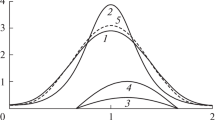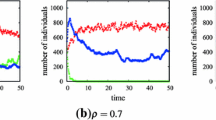Abstract
Two models of spatially extended population dynamics are investigated. Model A describes a lattice model of evolution of a predator -prey system. We compare four different strategies involving the problems of food resources, existence of cover against predators and birth. Properties of the steady states reached by the predator-prey system are analyzed. Model B concerns an individual-based model of a population which lives in a changing environment. The individuals forming the population are subject to mutations and selection pressure. We show that, depending on the values of the mutation rate and selection, the population may reach either an active phase (it will survive) or an absorbing phase (it will become extinct). The dependence of the mean time to extinction on the rate of mutations will also be discussed. These two problems illustrate the fact that cellular automata or Monte-Carlo simulations, which take completely the spatial fluctuations into account, are very useful tools to study population dynamics.
Access this chapter
Tax calculation will be finalised at checkout
Purchases are for personal use only
Preview
Unable to display preview. Download preview PDF.
Similar content being viewed by others
References
A.J. Lotka, Proc. Natl. Acad. Sci. U.S.A. 6, 410 (1920).
V. Volterra, ”Leçons sur la théorie mathématique de la lutte pour la vie”, (Gauthier-Villars, Paris 1931).
N.S. Goel, S.C. Maitra and E.W. Montroll, “Nonlinear models of interacting populations”, (Academic Press, New-York, 1971); J. Hofbauer, K. Sigmund, “Evolutionary Games and Population Dynamics”, (Cambridge Univ. Press, 1998).
P. Rohani, R.M. May and M.P. Hassell, J. Theor. Biol. 181, 97 (1996)
T. Antal and M. Droz, Phys. Rev 6.E, 1111 (2000).
M. Droz and A. Pcekalski, Phys. Rev 63E, 051909 (2001).
A.T. Bradshaw, L.L. Moseley, Physica A 261 107 (1998).
B. Chopard and M. Droz Cellular Automata Modeling of Physical Systems, Cambridge University Press (1998).
A. Lipowski and D. Lipowska, Physica A 276, 456 (2000).
H. Taitelbaum, Z. Koza, Y. Yanir and G.H. Weiss, Physica A 266, 280 (1999)
M. Droz and A. Pcekalski, Physica A298, 545 (2001).
M. Droz and A. Pcekalski, Phys. Rev E, to appear (May 2002)
M. Begon, M. Mortimer and D.J. Thompson Population Ecology, Blackwell Science Ltd, Oxford 1996.
A. Fraser and D. Burnell, Computer Models in Genetics, Mc Graw-Hill, New York 1970.
R. Bürger and M. Lynch, Evolution, 49, 151 (1995).
M. Lynch, J. Connery and R. Bürger, Evolution, 49, 1067 (1995).
R. Lande, Evolution, 48, 1460 (1994).
R. Gomulkiewicz and R.D. Holt, Evolution, 49, 201 (1995).
J.D. Murray, Mathematical Biology, Springer, Berlin 1993.
Author information
Authors and Affiliations
Editor information
Editors and Affiliations
Rights and permissions
Copyright information
© 2002 Springer-Verlag Berlin Heidelberg
About this paper
Cite this paper
Droz, M., Pȩkalski, A. (2002). Dynamics of Populations in Extended Systems. In: Bandini, S., Chopard, B., Tomassini, M. (eds) Cellular Automata. ACRI 2002. Lecture Notes in Computer Science, vol 2493. Springer, Berlin, Heidelberg. https://doi.org/10.1007/3-540-45830-1_18
Download citation
DOI: https://doi.org/10.1007/3-540-45830-1_18
Published:
Publisher Name: Springer, Berlin, Heidelberg
Print ISBN: 978-3-540-44304-9
Online ISBN: 978-3-540-45830-2
eBook Packages: Springer Book Archive




